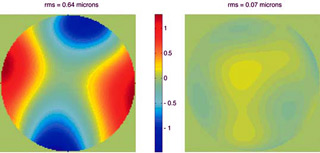| 2005 |

|
YEAR BOOK |
National University of Ireland, Galway
|
Adaptive optics in vision science: towards "super"-vision
|

An adaptive optics system has three basic components: a wavefront sensor that measures the image distortion, a deformable mirror (or other corrective device) that compensates for the distortion, and a control system that keeps the system working in close loop. The technologies for all three components are continually changing, principally to higher performance at lower cost.
Considered as an optical device, the eye has truly dreadful performance with very large aberrations, compared to those obtainable in modern optical instruments such as DVD players and cameras. It is a measure of the power of the visual processing carried out by the brain that we are able to see so well. The poor optics of the eye means that adaptive optics has a potential role, enabling the diffraction-limited optical resolution to be obtained.
Several research groups around the world are applying adaptive optics in vision science. One area of application is to the improvement of instruments that are used to image the retina: the fundus camera, laser scanning ophthalmoscope and optical coherence imager. Adaptive optics improves the image quality dramatically, allowing structures hitherto invisible to be visualised. A second area of application is to enhance vision, so-called "super"-vision.
In the SFI-funded Applied Optics Group at NUI Galway, we have built an adaptive optics system for enhanced vision, in collaboration with Imperial College, London. The figure below shows the excellent degree of correction obtained, from a root-mean-square wavefront error of 0.64 microns to 0.07 microns (about 1/8 of a wavelength) in this case. At present, Eugenie Dalimier, a PhD student in her second year, is planning psychophysical experiments of visual acuity in mesopic vision, that is, vision at intermediate light levels between cone and rod detection. This work is in collaboration with vision groups at City University, London and The University of Ulster at Coleraine and is also supported by the EU Research Training Network "Sharp-Eye".

|
|
Contact: Prof J C Dainty, Department of Experimental Physics,
NUI Galway, Galway.
Tel: +353 91 492826; Fax: +353 91 495529;
E-mail: [email protected] Web: http://optics.nuigalway.ie